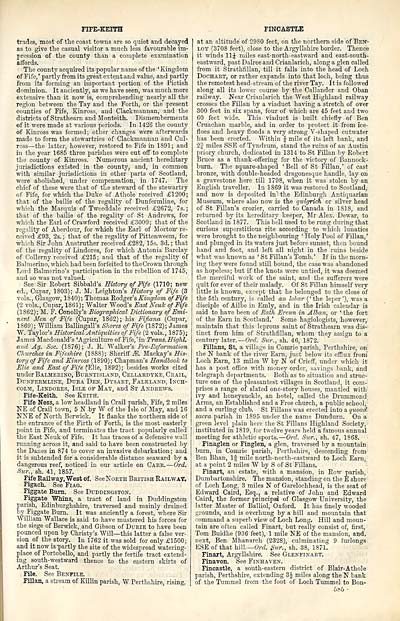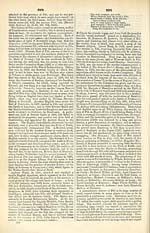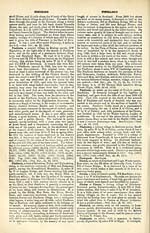Ordnance gazetteer of Scotland
(593) Page 585
Download files
Complete book:
Individual page:
Thumbnail gallery: Grid view | List view

FIFE-KEITH
trades, most of the coast towns are so quiet and decayed
as to give the casual visitor a much less favourable im-
pression of the county than a complete examination
aifords.
The county acquired its popular name of the 'Kingdom
of Fife,' partly from its great extent and value, and partly
from its forming an important portion of the Pictish
dominion. It anciently, as we have seen, was much more
extensive than it now is, comprehending nearly all the
region between the Tay and the Forth, or the present
counties of Fife, Kinross, and Clackmannan, and the
districts of Strath earn and Monteith. Dismemberments
of it were made at various periods. In 1426 the county
of Kinross was formed; other changes were afterwards
made to form the stewartries of Clackmannan and Cul-
ross — the latter, however, restored to Fife in 1891; and
in the year 1685 three parishes were cut off to complete
the county of Kinross. Numerous ancient hereditary
jurisdictions existed in the county, and, in common
with similar jurisdictions in other parts of Scotland,
were abolished, under compensation, in 1747. The
chief of these were that of the steward of the stewartry
of Fife, for which the Duke of Athole received £1200;
that of the bailie of the regality of Dunfermline, for
which the Marquis of Tweeddale received £2672, 7s. ;
that of the bailie of the regality of St Andrews, for
which the Earl of Crawford received £3000; that of the
regality of Aberdour, for which the Earl of Morton' re-
ceived £93, 2s. ; that of the regality of Pittenweem, for
which Sir John Anstruther received £282, 15s. 3d. ; that
of the regality of Lindores, for which Antonia Barclay
of Collerny received £215; and that of the regality of
Balmerino, which had been forfeited to the Crown through
Lord Balmerino's participation in the rebellion of 1745,
and so was not valued.
See Sir Robert Sibbald's History of Fife (1710; new
ed., Cupar, 1803); J. M. Leighton's History of Fife (3
vols., Glasgow, 1840); Thomas Rodger's Kingdom of Fife
(2 vols., Cupar, 1861); Walter Wood's East Neuk of Fife
(1862); M. F. Conolly's Biographical Dictionary of Emi-
nent Men of Fife (Cupar, 1862); his Fifiana (Cupar,
1S69); William Ballingall's Shores of Fife (1872); James
W. Taylor's Historical Antiquities of Fife (2 vols. , 1875);
James Macdonald's 'Agriculture of Fife,'in Trans. Highl.
and Ag. Soc. (1876); J. R. Walker's Pre-Ileformation
Churches in Fifcshire (188S); Sheriff iE. Mackay's His-
tory of Fife and Kinross (1890); Chapman's Handbook to
Elie and East of Fife (Elie, 1892); besides works cited
under Balmerino, Burntisland, Cellardyke, Crail,
Dunfermline, Dura Den, Dysart, Falkland, Inch-
colm, Lindores, Isle of Mat, and St Andrews.
Fife-Keith. See Keith.
Fife Ness, a low headland in Crail parish, Fife, 2 miles
NE of Crail town, 5 N by W of the Isle of May, and 16
NNE of North Berwick. It flanks the northern side of
the entrance of the Firth of Forth, is the most easterly
j>oint in Fife, and terminates the tract popularly called
the East Neuk of Fife. It has traces of a defensive wall
running across it, and said to have been constructed by
the Danes in 874 to cover an invasive debarkation ; and
it is subtended for a considerable distance seaward by a
dangerous reef, noticed in our article on Carr. — Ord.
Sur., sh. 41, 1857.
Fife Railway, West of. See North British Railway.
Figach. See Fiag.
Figgate Burn. See Duddingston.
Figgate Whins, a tract of land in Duddingston
parish, Edinburghshire, traversed and mainly drained
by. Figgate Burn. It was anciently a forest, where Sir
William Wallace is said to have mustered his forces for
the siege of Berwick, and Gibson of Durie to have been
pounced upon by Christy's Will— this latter a false ver-
sion of the story. In 1762 it was sold for only £1500;
and it now is partly the site of the widespread watering-
place of Portobello, and partly the fertile tract extend-
ing south-westward thence to the eastern skirts of
Arthur's Seat.
File. See Benfile.
Fillan, a stream of Killin parish, W Perthshire, rising,
FINCASTLE
at an altitude of 2980 feet, on the northern side of Ben-
loy (3708 feet), close to the Argyllshire border. Thence
it winds 11J miles east-north-eastward and east-south-
eastward, past Dalree and Crianlarich, along a glen called
from it Strathfillan, till it falls into the head of Loch
Doohart, or rather expands into that loch, being thus
the remotest head-stream of the river Tay. It is followed
along all its lower course by the Callander and Oban
railway. Near Crianlarich the West Highland railway
crosses the Fillan by a viaduct having a stretch of over
300 feet in six spans, four of which are 45 feet and two
60 feet wide. This viaduct is built chiefly of Ben
Cruachan marble, and in order to protect it from ice-
floes and heavy floods a very strong V-shaped cutwater
has been erected. Within J mile of its left bank, and
2J miles SSE of Tyndrum, stand the ruins of an Austin
priory church, dedicated in 1314 to St Fillan by Robert
Bruce as a thank-offering for the victory of Bannock-
burn. The square-shaped 'Bell of St Fillan,' of cast
bronze, with double-headed dragonesque handle, lay on
a gravestone here till 1798, when it was stolen by an
English traveller. In 1869 it was restored to Scotland,
and now is deposited in') the Edinburgh Antiquarian
Museum, where also now is the qu.igrich or silver head
of St Fillan's crozier, carried to Canada in 1S18, and
returned by its hereditary keeper, Mr Alex. Dewar, to
Scotland in 1877. This bell used to be rung during that
curious superstitious rite according to which lunatics
were brought to the neighbouring ' Holy Pool of Fillan,'
and plunged in its waters just before sunset, then bound
hand and foot, and left all night in the ruins beside
what was known as ' St Fillan's Tomb. ' If in the morn-
ing they were found still bound, the case was abandoned
as hopeless ; but if the knots were untied, it was deemed
the merciful work of the saint, and the sufferers were
quit for ever of their malady. Of St Fillan himself very
little is known, except that he belonged to the close of
the 5th century, is called an lobar ('the leper'), was a
disciple of Ailbe in Emly, and in the Irish calendar is
said to have been of Bath Erenn in Alban, or ' the fort
of the Earn in Scotland.' Some hagiologists, however,
maintain that this leprous saint of Strathearn was dis-
tinct from him of Strathfillan, whom they assign to a
century later. — Ord. Sur., sh. 46, 1872.
Fillans, St, a village in Comrie parish, Perthshire, on
the N bank of the river Earn, just below its efflux from
Loch Earn, 13 miles W by N of Crieff, under which it
has a post office with money order, savings bank, and
telegraph departments. Both as to situation and struc-
ture one of the pleasantest villages in Scotland, it com-
prises a range of slated one-story houses, mantled with
ivy and honeysuckle, an hotel, called the Drummond
Arms, an Established and a Free church, a public school,
and a curling club. St Fillans was erected into a quoad
sacra parish in 1895 under the name Dundurn. On a
green level plain here the St Fillans Highland Society,
instituted in 1819, for twelve years held a famous annual
meeting for athletic sports.— Ord. Sur., sh. 47, 1868.
Finaglen or Finglen, a glen, traversed by a mountain
burn, in Comrie parish, Perthshire, descending from
Ben Bhan, lg mile north-north-eastward to Loch Earn,
at a point 2 miles W by S of St Fillans.
Finart, an estate, with a mansion, in Row parish,
Dumbartonshire. The mansion, standing on the E shore
of Loch Long, 3 miles N of Garelochhead, is the seat of
Edward Caird, Esq., a relative of John and Edward
Caird, the former principal of Glasgow University, the
latter Master of Balliol, Oxford. It has finely wooded
grounds, and is overhung by a hill and mountain that
command a superb view of Loch Long. Hill and moun-
tain are often called Finart, but really consist of, first,
Tom Buidhe (936 feet), 1 mile NE of the mansion, and,
next, Ben Mhanarch (2328), culminating 9 furlongs
ESE of that hill— Ord. Sur., sh. 38, 1871.
Finart, Argyllshire. See Glenfinart.
Finavon. See Finhaven.
Fincastle, a south-eastern district of Blair-Athole
parish, Perthshire, extending 3J miles along the N bank
of the Tummel from the foot of Loch Tummel to Bon-
trades, most of the coast towns are so quiet and decayed
as to give the casual visitor a much less favourable im-
pression of the county than a complete examination
aifords.
The county acquired its popular name of the 'Kingdom
of Fife,' partly from its great extent and value, and partly
from its forming an important portion of the Pictish
dominion. It anciently, as we have seen, was much more
extensive than it now is, comprehending nearly all the
region between the Tay and the Forth, or the present
counties of Fife, Kinross, and Clackmannan, and the
districts of Strath earn and Monteith. Dismemberments
of it were made at various periods. In 1426 the county
of Kinross was formed; other changes were afterwards
made to form the stewartries of Clackmannan and Cul-
ross — the latter, however, restored to Fife in 1891; and
in the year 1685 three parishes were cut off to complete
the county of Kinross. Numerous ancient hereditary
jurisdictions existed in the county, and, in common
with similar jurisdictions in other parts of Scotland,
were abolished, under compensation, in 1747. The
chief of these were that of the steward of the stewartry
of Fife, for which the Duke of Athole received £1200;
that of the bailie of the regality of Dunfermline, for
which the Marquis of Tweeddale received £2672, 7s. ;
that of the bailie of the regality of St Andrews, for
which the Earl of Crawford received £3000; that of the
regality of Aberdour, for which the Earl of Morton' re-
ceived £93, 2s. ; that of the regality of Pittenweem, for
which Sir John Anstruther received £282, 15s. 3d. ; that
of the regality of Lindores, for which Antonia Barclay
of Collerny received £215; and that of the regality of
Balmerino, which had been forfeited to the Crown through
Lord Balmerino's participation in the rebellion of 1745,
and so was not valued.
See Sir Robert Sibbald's History of Fife (1710; new
ed., Cupar, 1803); J. M. Leighton's History of Fife (3
vols., Glasgow, 1840); Thomas Rodger's Kingdom of Fife
(2 vols., Cupar, 1861); Walter Wood's East Neuk of Fife
(1862); M. F. Conolly's Biographical Dictionary of Emi-
nent Men of Fife (Cupar, 1862); his Fifiana (Cupar,
1S69); William Ballingall's Shores of Fife (1872); James
W. Taylor's Historical Antiquities of Fife (2 vols. , 1875);
James Macdonald's 'Agriculture of Fife,'in Trans. Highl.
and Ag. Soc. (1876); J. R. Walker's Pre-Ileformation
Churches in Fifcshire (188S); Sheriff iE. Mackay's His-
tory of Fife and Kinross (1890); Chapman's Handbook to
Elie and East of Fife (Elie, 1892); besides works cited
under Balmerino, Burntisland, Cellardyke, Crail,
Dunfermline, Dura Den, Dysart, Falkland, Inch-
colm, Lindores, Isle of Mat, and St Andrews.
Fife-Keith. See Keith.
Fife Ness, a low headland in Crail parish, Fife, 2 miles
NE of Crail town, 5 N by W of the Isle of May, and 16
NNE of North Berwick. It flanks the northern side of
the entrance of the Firth of Forth, is the most easterly
j>oint in Fife, and terminates the tract popularly called
the East Neuk of Fife. It has traces of a defensive wall
running across it, and said to have been constructed by
the Danes in 874 to cover an invasive debarkation ; and
it is subtended for a considerable distance seaward by a
dangerous reef, noticed in our article on Carr. — Ord.
Sur., sh. 41, 1857.
Fife Railway, West of. See North British Railway.
Figach. See Fiag.
Figgate Burn. See Duddingston.
Figgate Whins, a tract of land in Duddingston
parish, Edinburghshire, traversed and mainly drained
by. Figgate Burn. It was anciently a forest, where Sir
William Wallace is said to have mustered his forces for
the siege of Berwick, and Gibson of Durie to have been
pounced upon by Christy's Will— this latter a false ver-
sion of the story. In 1762 it was sold for only £1500;
and it now is partly the site of the widespread watering-
place of Portobello, and partly the fertile tract extend-
ing south-westward thence to the eastern skirts of
Arthur's Seat.
File. See Benfile.
Fillan, a stream of Killin parish, W Perthshire, rising,
FINCASTLE
at an altitude of 2980 feet, on the northern side of Ben-
loy (3708 feet), close to the Argyllshire border. Thence
it winds 11J miles east-north-eastward and east-south-
eastward, past Dalree and Crianlarich, along a glen called
from it Strathfillan, till it falls into the head of Loch
Doohart, or rather expands into that loch, being thus
the remotest head-stream of the river Tay. It is followed
along all its lower course by the Callander and Oban
railway. Near Crianlarich the West Highland railway
crosses the Fillan by a viaduct having a stretch of over
300 feet in six spans, four of which are 45 feet and two
60 feet wide. This viaduct is built chiefly of Ben
Cruachan marble, and in order to protect it from ice-
floes and heavy floods a very strong V-shaped cutwater
has been erected. Within J mile of its left bank, and
2J miles SSE of Tyndrum, stand the ruins of an Austin
priory church, dedicated in 1314 to St Fillan by Robert
Bruce as a thank-offering for the victory of Bannock-
burn. The square-shaped 'Bell of St Fillan,' of cast
bronze, with double-headed dragonesque handle, lay on
a gravestone here till 1798, when it was stolen by an
English traveller. In 1869 it was restored to Scotland,
and now is deposited in') the Edinburgh Antiquarian
Museum, where also now is the qu.igrich or silver head
of St Fillan's crozier, carried to Canada in 1S18, and
returned by its hereditary keeper, Mr Alex. Dewar, to
Scotland in 1877. This bell used to be rung during that
curious superstitious rite according to which lunatics
were brought to the neighbouring ' Holy Pool of Fillan,'
and plunged in its waters just before sunset, then bound
hand and foot, and left all night in the ruins beside
what was known as ' St Fillan's Tomb. ' If in the morn-
ing they were found still bound, the case was abandoned
as hopeless ; but if the knots were untied, it was deemed
the merciful work of the saint, and the sufferers were
quit for ever of their malady. Of St Fillan himself very
little is known, except that he belonged to the close of
the 5th century, is called an lobar ('the leper'), was a
disciple of Ailbe in Emly, and in the Irish calendar is
said to have been of Bath Erenn in Alban, or ' the fort
of the Earn in Scotland.' Some hagiologists, however,
maintain that this leprous saint of Strathearn was dis-
tinct from him of Strathfillan, whom they assign to a
century later. — Ord. Sur., sh. 46, 1872.
Fillans, St, a village in Comrie parish, Perthshire, on
the N bank of the river Earn, just below its efflux from
Loch Earn, 13 miles W by N of Crieff, under which it
has a post office with money order, savings bank, and
telegraph departments. Both as to situation and struc-
ture one of the pleasantest villages in Scotland, it com-
prises a range of slated one-story houses, mantled with
ivy and honeysuckle, an hotel, called the Drummond
Arms, an Established and a Free church, a public school,
and a curling club. St Fillans was erected into a quoad
sacra parish in 1895 under the name Dundurn. On a
green level plain here the St Fillans Highland Society,
instituted in 1819, for twelve years held a famous annual
meeting for athletic sports.— Ord. Sur., sh. 47, 1868.
Finaglen or Finglen, a glen, traversed by a mountain
burn, in Comrie parish, Perthshire, descending from
Ben Bhan, lg mile north-north-eastward to Loch Earn,
at a point 2 miles W by S of St Fillans.
Finart, an estate, with a mansion, in Row parish,
Dumbartonshire. The mansion, standing on the E shore
of Loch Long, 3 miles N of Garelochhead, is the seat of
Edward Caird, Esq., a relative of John and Edward
Caird, the former principal of Glasgow University, the
latter Master of Balliol, Oxford. It has finely wooded
grounds, and is overhung by a hill and mountain that
command a superb view of Loch Long. Hill and moun-
tain are often called Finart, but really consist of, first,
Tom Buidhe (936 feet), 1 mile NE of the mansion, and,
next, Ben Mhanarch (2328), culminating 9 furlongs
ESE of that hill— Ord. Sur., sh. 38, 1871.
Finart, Argyllshire. See Glenfinart.
Finavon. See Finhaven.
Fincastle, a south-eastern district of Blair-Athole
parish, Perthshire, extending 3J miles along the N bank
of the Tummel from the foot of Loch Tummel to Bon-
Set display mode to: Large image | Transcription
Images and transcriptions on this page, including medium image downloads, may be used under the Creative Commons Attribution 4.0 International Licence unless otherwise stated. ![]()
| Gazetteers of Scotland, 1803-1901 > Ordnance gazetteer of Scotland > (593) Page 585 |
|---|
| Permanent URL | https://digital.nls.uk/97400362 |
|---|

